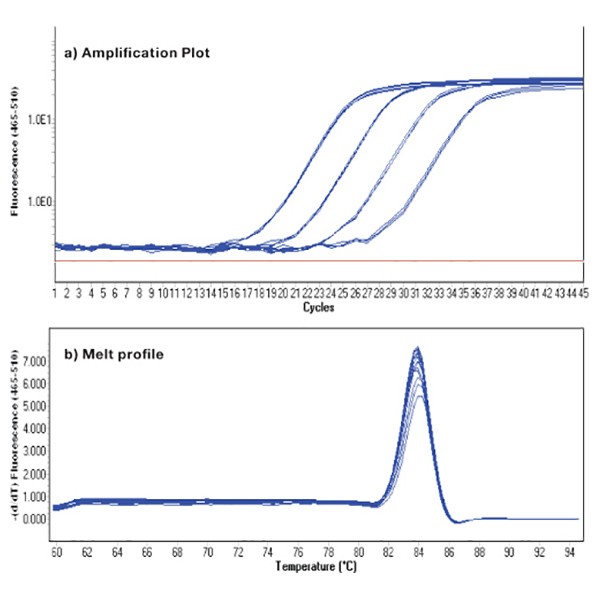Ordering
*link will take you to our exclusive distribution partner site
*link will take you to our exclusive distribution partner site
The SensiFAST™ SYBR No-ROX Kit has been developed for fast, highly accurate real-time PCR and has been validated on all commonly-used real-time instruments that do not require the passive reference dye ROX.
A combination of the latest advances in buffer chemistry and PCR enhancers ensures that the SensiFAST SYBR No-ROX Kit produces reliable assay results under fast thermal cycling conditions. An antibody-mediated hot-start DNA polymerase system promotes highly-specific amplification, in turn improving assay sensitivity and dynamic range.
The SensiFAST SYBR® No-ROX Kit has been optimized to deliver optimal performance in tandem with the SensiFAST cDNA Synthesis Kit, which offers fast, unbiased cDNA synthesis, without compromising cDNA yield or coverage.

Fig. 1 SensiFAST SYBR using fast cycling conditions
The rps18 gene was amplified using SensiFAST SYBR No-ROX used a 10 fold serial dilution of cDNA over four orders of magnitude. The results illustrate that SensiFAST SYBR No-ROX is a fast (early Ct), highly reproducible and sensitive kit, with do detectable primer-dimers.
|
Reagent |
500 x 20 µL Reactions |
2000 x 20 µL Reactions |
5000 x 20 µL Reactions |
|
SensiFAST SYBR® No-ROX mix (2x) |
5 x 1 mL |
4 x 5 mL |
10 x 5 mL |
BIO-98005: 500 x 20 µL Reactions: 5 x 1ml
BIO-98020: 2000 x 20 µL Reactions: 4 x 5ml
BIO-98050: 5000 x 20 µL Reactions: 10 x 5 mL
All kit components should be stored at -20°C upon receipt for optimum stability. Repeated freeze/thaw cycles should be avoided. Avoid exposure of the SYBR® Green I to light.
When stored under the recommended conditions and handled correctly, full activity of the kit is retained until the expiry date indicated on the outer box label.
SensiFAST SYBR® No-ROX Kit is shipped on dry/blue ice